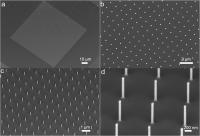Harvard University and Zena Technologies researchers led by Kenneth B. Crozier have discovered that single vertical silicon nanowires can shine in all the rainbow colors.
The display depends on the diameter of each wire, and can be seen by the naked eye. The discovery can be used in nanoscale image sensors for enhanced efficiency in identifying color without needing filters.
 Hrvard's Vertical Silicon Nanowires
Hrvard's Vertical Silicon Nanowires
According to Crozier, John L. Loeb associate professor of the Natural Sciences at Harvard School of Engineering and Applied Science (SEAS), the vertical configuration allows strong color effects to be clearly visible, and they can be tuned to multiple wavelengths of the area that is visible. The effects are visible at the level of single wires.
The research paper was published in the March 17 online issue of Nano Letters, and reveals that silicon nanowires could assume multiple colors based on their diameter when bright light is beamed on to them.
The team used electron beam lithography combined with inductively coupled plasma reactive ion etching to help create the multicolored array of vertical silicon nanowires, A smooth silicon wafer was plasma etched until vertical nanowires remained. The array looked like toothbrush bristles. The colors were exhibited because of the properties of each wire.
The nanowires serve as waveguides like an optically absorbing fiber. The coupling is better on long wavelengths than the short ones, but there is little absorption. Between these, a range of wavelengths exist where the light is joined to the nanowire and absorbed. Even a small change in the diameter can change the color. The technology can be used in image sensors.
Source: http://www.harvard.edu/